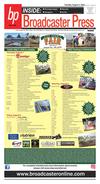053116_YKBP_A2.pdf







2 Broadcaster Press
May 31, 2016 www.broadcasteronline.com
On June 1, State Sales Tax Goes Up To Help
Teachers, Property Owners, Six Days
Before Primary Elections
BY BOB MERCER
State Capitol Bureau
PIERRE – Two major events converge in the coming week in South
Dakota.
The statewide sales tax increases
on June 1 to 4.5 percent from 4 percent, after a knockdown fight within
the Legislature last winter over Gov.
Dennis Daugaard’s plan to improve
pay for last-place schoolteachers,
and provide property-tax relief to
business owners for the first time,
after homeowners and agriculture
producers received reductions 20
years ago.
And South Dakota voters cast
their ballots in party primary elections on June 7 that will greatly determine the direction of the Republican Party, whose members rule the
Legislature as super-majorities, in
what many candidates are casting as
a referendum on the Republican governor’s approach the past two years
and his final two years remaining.
What wasn’t debated among
lawmakers during the sales-tax fight,
and still isn’t being discussed to any
great extent in the primary campaigns, is the tax itself. There are
two important sets of facts to know.
The 4 percent rate wasn’t sufficient to pay for any significant
amount of increased state aid to
public schools, without making
changes in spending elsewhere in
state government’s budget.
Daugaard began as governor in
2011 by asking the Legislature for 10
percent cuts throughout most of the
budget and slightly smaller cuts in
school aid and funding for Medicaid
providers. Lawmakers agreed the
austerity was needed. But four years
later, the Legislature still hadn’t
restored the money taken from
schools in 2011.
The second important set of facts
is the volatility that developed in
sales tax revenue. The tax changed
from a reliable, steadily rising source
of funding. It turned wildly erratic.
Consider these two sets of numbers.
From 1999 through 2008, the tax
generated increased revenues by
annual percentages of 4.70, 5.22,
5.51, 1.30, 3.91, 6.63, 6.63, 7.92, 4.70
and 6.92.
When the nation’s great reces-
sion gripped South Dakota, the tax
revenues went into a haywire period.
The growth slumped to 2.18 percent
in 2009. Then sales tax revenue actually decreased in 2010, falling by 2.45
percent. That prompted the budget
cuts. In 2011, the revenue spiked 10.4
percent. That partially made up for
the slump in the two prior years. But
the state’s economy, as measured in
sales tax activity, didn’t return to its
pre-recession level. The tax revenue
increased 4.81 percent during 2012,
then 4.30 and 5.82 the next two
years.
The 5.82 percent looked encouraging, until another deep slump. The
growth during 2015 was 0.87 percent.
The real-life numbers, as expressed in millions of dollars, were
staggering. The actual amount in
2015 came in $17 million below the
amount that legislators had budgeted. Hope of somehow restoring the
state aid to schools became more
remote as each year passed.
The before-and-after came
through in two sets of statistics from
the state Bureau of Finance and
Management.
In a pre-recession analysis, the
bureau reported the average annual
net increase in sales tax collections
from 2001 to 2008 was 5.13 percent.
That included the 2001-era downturn
in the economy.
In a current analysis, looking at
the period immediately before the
2009 recession and continuing after
it, the bureau calculated the average
annual net increase in sales tax collections for 2007 through 2015 was
4.17 percent.
A difference of 1 percent doesn’t
seem like much for one year.
Compounded over seven or eight
years, the difference becomes more
significant.
Exactly what has changed in
South Dakota’s economic activity
to cause the changes in spending –
because that’s what a sales tax does,
it reflects spending -- isn’t clear.
The tax increase to 4.5 percent
also produces a slight shift in tax
burden. Consumers will pay an
estimated $107 million more in state
sales tax during fiscal 2017 that
starts July 1, 2016. Property owners
will receive $37 million of that revenue through lower school-tax levies
on their land and buildings.
Public schools will get $67 million
of additional state aid and will be
required to use nearly all of it to pay
teachers more. Another $3 million is
earmarked for instructors at the four
technical institutes run by public
school districts in Watertown, Mitchell, Rapid City and Sioux Falls.
The key in the tax shift is an entire class of property now becomes
eligible for tax relief. In the original
1995 package, only owner-occupied
homes and agricultural property
were covered. Now all other property will be covered, including businesses, rental housing and second
homes.
With the increase to 4.5 percent,
annual state sales tax collections
are forecast to pass the $1 billion
threshold for the first time by June
30, 2017. The expected sales tax revenue for fiscal 2017 that starts July 1,
2016, is $1,006,724,206.
Basically the tax increase will allow state government to make public
schools whole again on their state
funding. None of the opponents in
the Legislature to the tax increase
brought a formal list of budget
cuts that could have made the tax
increase avoidable.
The tax increase does include a
rollback provision in an amendment
that came from Rep. Jeff Partridge,
R-Rapid City. As state government
collects more sales-tax revenue from
remote sellers located outside South
Dakota, the tax increase would be
gradually reduced.
At the same time, the Legislature
and the governor adopted a plan
to aggressively pursue sales-tax
collections from remote sellers. The
legislation is intended to convince
remote sellers they need to charge
state sales taxes and remit the
money to South Dakota – or provoke
a lawsuit that could resolve the
national issue of whether states can
collect sales tax on remote sales.
None of the people in the Capitol
last winter argued that enough tax
revenue could come from remote
sellers to offset the $107 million that
is expected from the tax increase,
however.
How much money might be
produced from remote sales is a
mystery cloaked in estimates that
run in the tens of millions rather
than hundreds of millions.
The bottom line
is that the governor
and two-thirds of the
105 legislators decided the 4 percent
sales tax couldn’t
keep up with the
established needs
in the changing
economy.
The 4 percent
rate had been in
place since 1969. The
sales tax began in
1935, amid the great
•
depression, at 2 percent. The Legislature
raised the rate to 3
percent in 1965, then
four years later to 4
1969.
www.KnutsonFamilyDentistry.com percent inthe LegislaTwice
ture increased the rate to 5 percent
temporarily for special purposes.
It was 5 percent from May 1980 to
June 1981 to pay for South Dakota’s
purchase of bankrupt railroad lines
throughout South Dakota during the
first term of Gov. Bill Janklow.
It was 5 percent again from May
1987 to February 1988 to raise $80
million for the state business-loan
program known as the REDI fund
during the first term of Gov. George
S. Mickelson.
In key ways the new increase to
4.5 percent is tied to the propertytax revolt of 1994. Voters nearly
approved a limit on property taxes
that would have cut collections for
schools and local governments by
approximately two-thirds. There
wasn’t a replacement source of
funding.
The Democratic candidate for
governor, Jim Beddow, promised to
reduce property taxes by 30 percent
if elected that year. Janklow, making
his comeback for a third term as the
Republican nominee, matched Beddow’s promise. The tax limit failed
on the ballot by less than 1 percent
of the votes cast.
That led to the 1995 tax-relief
package and the caps on propertytax increases passed by the Legislature and the governor. A variety of
maneuvers generated the first $80
million of relief. Janklow and the Legislature gradually found the remaining $40 million in the subsequent
years by limiting the growth of state
government.
Local governments and school
boards were given the ability to
opt out of the property-tax limits,
subject to local votes. Many optouts have passed and many have
failed since then, but they generally
were to preserve services or keep a
school open. The bigger argument
on schools always called for more
state aid.
Meanwhile schoolteachers were
mired in their status as the lowestpaid in the nation. A push by school
administrators in the past few years
to show their difficulties in recruiting
teachers to lower-paying rural districts gradually convinced Daugaard
and many legislators to take the bold
step of a sales tax increase.
On June 1, people making purchases in South Dakota will pay an
additional one-half of one percent of
state sales tax. On June 7, voters in
South Dakota will mark their ballots
in legislative primary elections in
many of the 35 legislative districts
where the fights have been, at least
in part, over the tax increase.
Dr. Richard Knutson, D.D.S Dr. Matthew Knutson, D.D.S
605-624-6291
I want you...
S.E. Ward
to Vote
Get your ad in the..
Classifieds
Today!
CALL: 624-4429 or FAX: 624-2696
EMAIL: classifieds@plaintalk.net
ONLINE: BroadcasterOnline.com
DROP BY: 201 W. Cherry, Vermillion
Hazardous
Occupations
Safety
Training in
Agriculture
for Youth
Farm/Ranch
Workers
BROOKINGS – SDSU Extension will be conducting a
Hazardous Occupations Safety
Training in Agriculture June
15 and 16, 2016 at Lake Area
Technical Institute in the Ag
Department.
The training will be held
June 15 from 8:30 a.m. to 5
p.m. and then again on June 16
from 8:30 a.m. to 5 p.m. A test
will be held the afternoon of
June 16. Those who pass the
test will receive certification.
Currently, the law states
that any individual who is 14
to 15 years old must be trained
on the safe operation of tractors, farm machinery and
other hazardous activities in
the agricultural industry. One
exception to the rule is youth
who are employed on their
home farm.
This means all 14 to 15
year olds who are seeking
employment in the agriculture
industry must receive the
training as required by the
U.S. Department of Labor, with
the only exemption being for
youth working on their own
farm. When youth become 16
years of age, this law no longer
applies to their employment.
Youth who are working on
their family farm are also
encouraged to attend, as are
older youth.
The training consists of a
combination of independent
study, materials will be sent
to participants prior to the
training. The trainer will be
Bailey Hurlbert, Ag Instructor,
Lake Area Technical Institute
of Watertown.
To register visit, http://
www.iGrow.org/events. To
cover the cost of participant
materials, the fee for this training is $30. Online registration
closes June 14.
More on the importance of
Hazardous Occupations Safety
Training in Agriculture
The agricultural industry is
the only industry in the U.S.A.
that allows youth under the
age of 16 to be considered a
legal employee.
"When coupled with the
fact that farming/ranching is
considered to be one of the
top 10 most dangerous jobs;
it is evident that we must
educate youth about dangers
on farms and ranches for the
safety of both themselves and
others," said Alvaro Garcia,
SDSU Extension Agriculture and Natural Resources
Program Director & Professor. "The number one way to
prevent on farm accidents is
by educating about possible
dangers and giving students
the knowledge to asses a situation for all possible hazards."
Aetrex SUMMER SALE
Men
Make Your Feet Happy
Women
Boston Shoes to Boots
312 W. 3rd Yankton • 665-9092
Re?ned Consignment Studio
1108 West Cedar • Suite 2
Beresford, SD
Starlite Plaza next to Subway
New owner as of 6/1/2016.
Angie Twedt announces the addition
of kids clothing!
Starting Saturday, 6/4/16, we will take
on consignment –
Your name brand, gently used kids
clothing and shoes along with womens,
juniors, mens and home décor.
New Summer Hours
Tuesday – Friday: 9:00am – 5:00pm
Saturday: 9:00am – 3:00pm
Closed: Sunday and Monday
Wes Christensen
for
City Council
Paid for by Candidate
• Rent adjusted to your income
• Large 2 & 3 Bedroom units w/ A/C
• Large Closets - one is walk-in
• Off - Street parking
• On-site coin laundry
• Playground equipment
• Just blocks from Campus, High School &
Prentis Park
OAKWOOD APARTMENTS
1200 E Clark St. • Vermillion
Call Nikki or Dave
(605) 624-9557


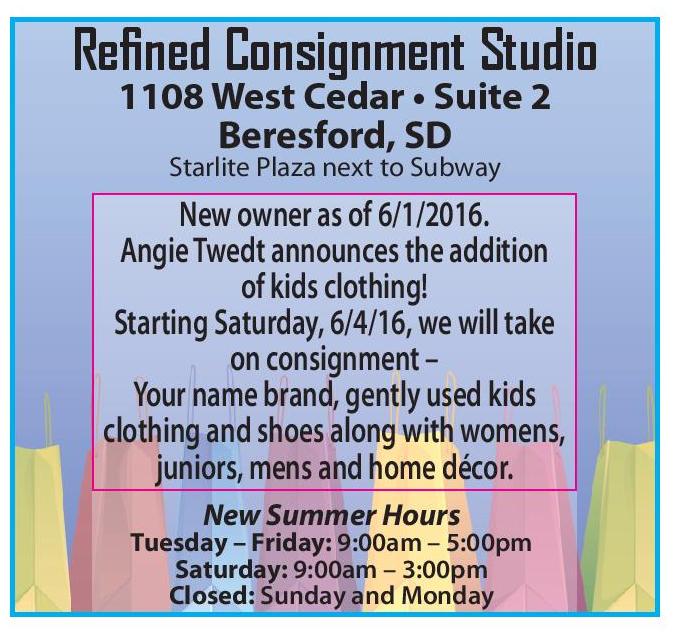





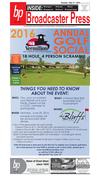
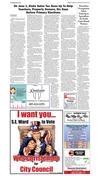

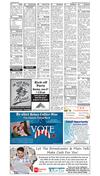
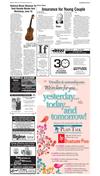
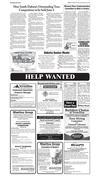

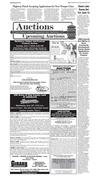

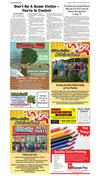
 Previous Page
Previous Page






